15.2 Cognitive Development
15-2 From the perspectives of Piaget, Vygotsky, and today’s researchers, how does a child’s mind develop?
Somewhere on your precarious journey “from egghood to personhood” (Broks, 2007), you became conscious. When was that? In search of the conscious thoughts of an infant—or, rather, a neural signal that marks early conscious awareness—one French research team flashed faces on a screen. At first, the faces appeared so briefly that even adults could not consciously perceive them. Gradually, the presentation slowed until an adult brain-wave response signaled conscious awareness, about 300 milliseconds after an image appeared. With more exposure time while looking at the faces, 5-month-old infants displayed the same brain signature of visual awareness (Dehaene, 2014; Kouider et al., 2013).
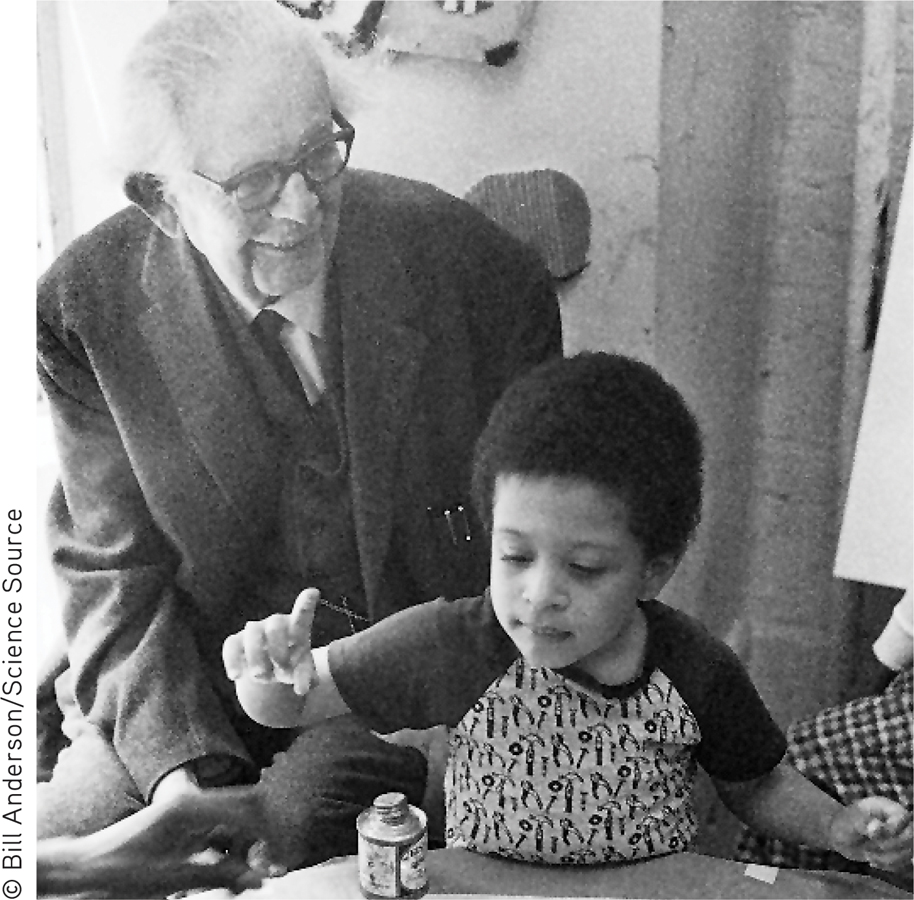
If you, too, were consciously aware then, how did your mind unfold from there? Developmental psychologist Jean Piaget [pee-ah-ZHAY] spent his life searching for the answers to such questions. He studied children’s cognitive development—all the mental activities associated with thinking, knowing, remembering, and communicating. His interest began in 1920, when he was in Paris developing questions for children’s intelligence tests. While administering the tests, Piaget became intrigued by children’s wrong answers, which were often strikingly similar among same-age children. Where others saw childish mistakes, Piaget saw intelligence at work.
A half-century spent with children convinced Piaget that a child’s mind is not a miniature model of an adult’s. Thanks partly to his work, we now understand that children reason differently than adults, in “wildly illogical ways about problems whose solutions are self-evident to adults” (Brainerd, 1996).
Piaget’s studies led him to believe that a child’s mind develops through a series of stages, in an upward march from the newborn’s simple reflexes to the adult’s abstract reasoning power. Thus, an 8-year-old can comprehend things a toddler cannot, such as the analogy that “getting an idea is like having a light turn on in your head,” or that a miniature slide is too small for sliding, and a miniature car is much too small to get into (FIGURE 15.3).
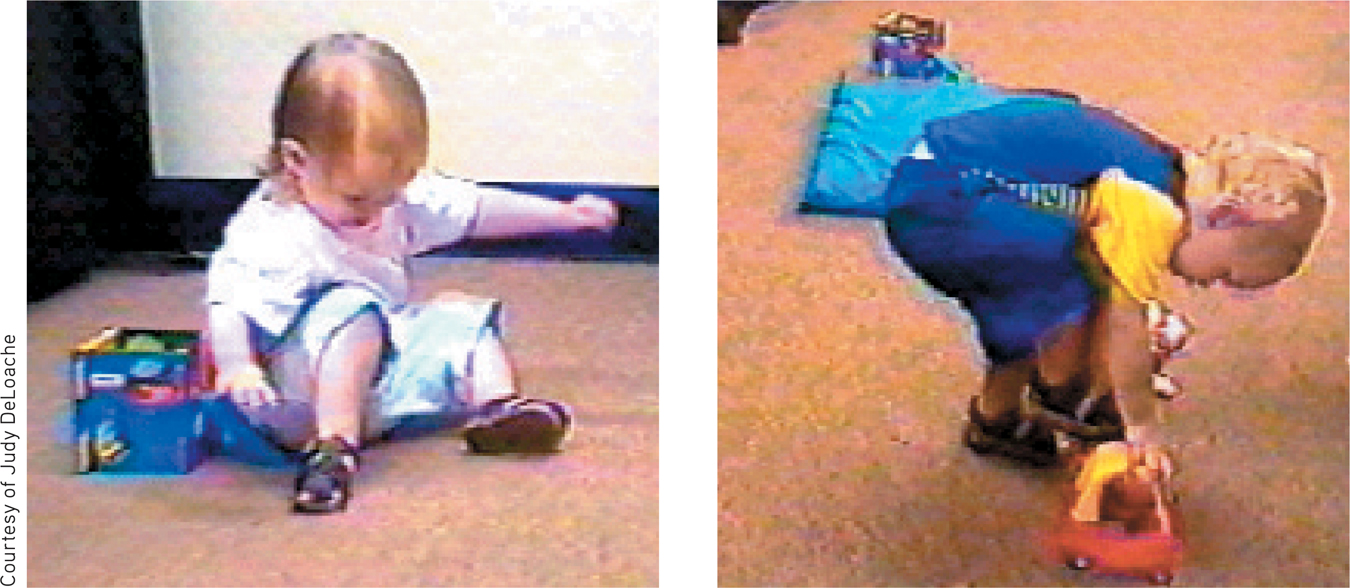
 Figure 15.3
Figure 15.3Scale errors Psychologists Judy DeLoache, David Uttal, and Karl Rosengren (2004) report that 18-to 30-month-old children may fail to take the size of an object into account when trying to perform impossible actions with it. At left, a 21-month-old attempts to slide down a miniature slide. At right, a 24-month-old opens the door to a miniature car and tries to step inside.
Piaget’s core idea was that our intellectual progression reflects an unceasing struggle to make sense of our experiences. To this end, the maturing brain builds schemas, concepts or mental molds into which we pour our experiences (FIGURE 15.4). By adulthood we have built countless schemas, ranging from cats and dogs to our concept of love.

 Figure 15.4
Figure 15.4An impossible object Look carefully at the “devil’s tuning fork.” Now look away—no, better first study it some more—and then look away and draw it…. Not so easy, is it? Because this tuning fork is an impossible object, you have no schema for such an image.
To explain how we use and adjust our schemas, Piaget proposed two more concepts. First, we assimilate new experiences—we interpret them in terms of our current understandings (schemas). Having a simple schema for dog, for example, a toddler may call all four-legged animals dogs. But as we interact with the world, we also adjust, or accommodate, our schemas to incorporate information provided by new experiences. Thus, the child soon learns that the original dog schema is too broad and accommodates by refining the category (FIGURE 15.5). Many people whose schema of marriage was a man-woman union have now accommodated same-sex marriages, with a broadened marriage concept.
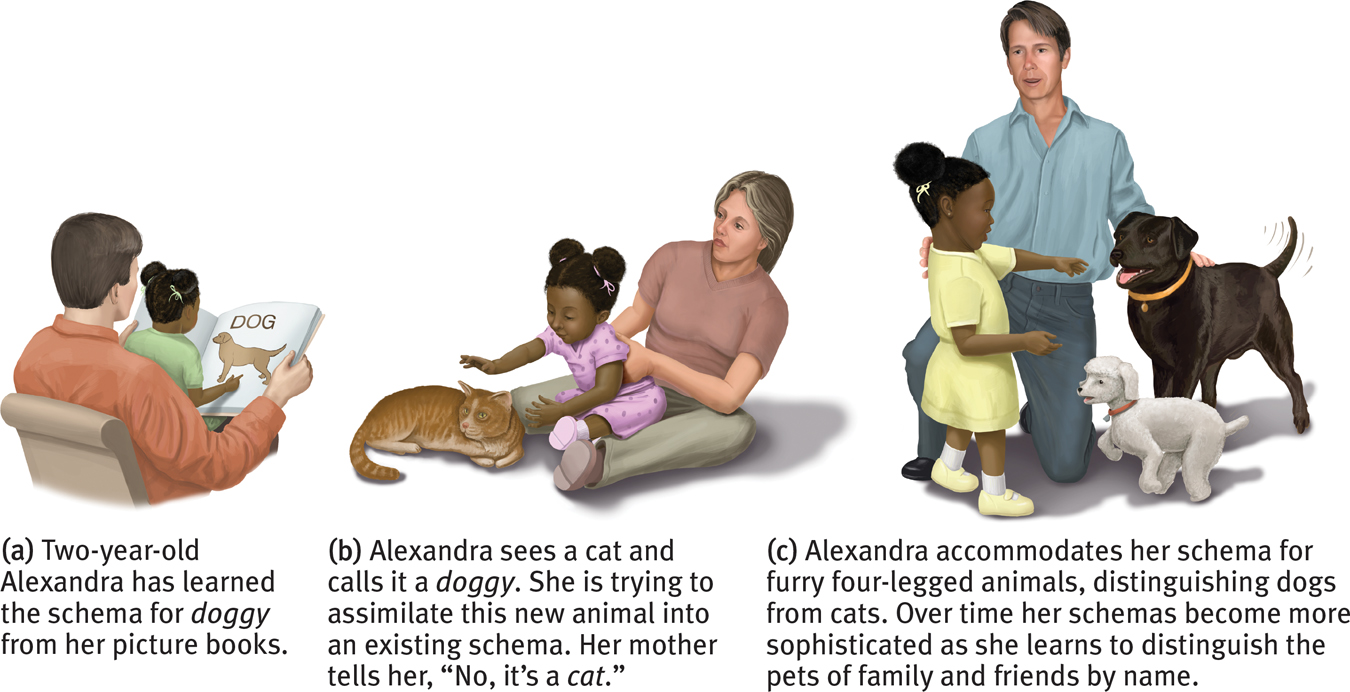
 Figure 15.5
Figure 15.5Pouring experience into mental molds We use our existing schemas to assimilate new experiences. But sometimes we need to accommodate (adjust) our schemas to include new experiences.
Piaget’s Theory and Current Thinking
Piaget believed that children construct their understanding of the world while interacting with it. Their minds experience spurts of change, followed by greater stability as they move from one cognitive plateau to the next, each with distinctive characteristics that permit specific kinds of thinking. In Piaget’s view, cognitive development consisted of four major stages—sensorimotor, preoperational, concrete operational, and formal operational.
Sensorimotor StageIn the sensorimotor stage, from birth to nearly age 2, babies take in the world through their senses and actions—through looking, hearing, touching, mouthing, and grasping. As their hands and limbs begin to move, they learn to make things happen.
Very young babies seem to live in the present: Out of sight is out of mind. In one test, Piaget showed an infant an appealing toy and then flopped his beret over it. Before the age of 6 months, the infant acted as if the toy ceased to exist. Young infants lack object permanence—the awareness that objects continue to exist even when not perceived. By 8 months, infants begin exhibiting memory for things no longer seen. If you hide a toy, the infant will momentarily look for it (FIGURE 15.6). Within another month or two, the infant will look for it even after being restrained for several seconds.

 Figure 15.6
Figure 15.6Object permanence Infants younger than 6 months seldom understand that things continue to exist when they are out of sight. But for this older infant, out of sight is definitely not out of mind.
So does object permanence in fact blossom suddenly at 8 months, much as tulips blossom in spring? Today’s researchers believe object permanence unfolds gradually, and they see development as more continuous than Piaget did. Even young infants will at least momentarily look for a toy where they saw it hidden a second before (Wang et al., 2004).
Researchers also believe Piaget and his followers underestimated young children’s competence. Preschoolers think like little scientists. They test ideas, make causal inferences, and learn from statistical patterns (Gopnik, 2012). Consider these simple experiments:
- Baby physics: Like adults staring in disbelief at a magic trick (the “Whoa!” look), infants look longer at an unexpected and unfamiliar scene of a car seeming to pass through a solid object, a ball stopping in midair, or an object violating object permanence by magically disappearing (Baillargeon, 1995, 2008; Wellman & Gelman, 1992).
- Baby math: Karen Wynn (1992, 2000, 2008) showed 5-month-olds one or two objects (FIGURE 15.7a). Then she hid the objects behind a screen, and visibly removed or added one (Figure 15.7d). When she lifted the screen, the infants sometimes did a double take, staring longer when shown a wrong number of objects (Figure 15.7f). But were they just responding to a greater or smaller mass of objects, rather than a change in number (Feigenson et al., 2002)? Later experiments showed that babies’ number sense extends to larger numbers, to ratios, and to such things as drumbeats and motions (Libertus & Brannon, 2009; McCrink & Wynn, 2004; Spelke et al., 2013). If accustomed to a Daffy Duck puppet jumping three times on stage, they showed surprise if it jumped only twice.

 Figure 15.7
Figure 15.7
Baby math Shown a numerically impossible outcome, 5-month-old infants stare longer. (From Wynn, 1992.)
Clearly, infants are smarter than Piaget appreciated. Even as babies, we had a lot on our minds.
Preoperational StagePiaget believed that until about age 6 or 7, children are in a preoperational stage—able to represent things with words and images but too young to perform mental operations (such as imagining an action and mentally reversing it). For a 5-year-old, the milk that seems “too much” in a tall, narrow glass may become an acceptable amount if poured into a short, wide glass. Focusing only on the height dimension, this child cannot perform the operation of mentally pouring the milk back. Before about age 6, said Piaget, children lack the concept of conservation—the principle that quantity remains the same despite changes in shape (FIGURE 15.8).

 Figure 15.8
Figure 15.8Piaget’s test of conservation This visually focused preoperational child does not yet understand the principle of conservation. When the milk is poured into a tall, narrow glass, it suddenly seems like “more” than when it was in the shorter, wider glass. In another year or so, she will understand that the amount stays the same.
Piaget did not view the stage transitions as abrupt. Even so, symbolic thinking, and with it pretend play, appear at an earlier age than he supposed. Judy DeLoache (1987) discovered this when she showed children a model of a room and hid a miniature stuffed dog behind its miniature couch. The 2½-year-olds easily remembered where to find the miniature toy, but they could not use the model to locate an actual stuffed dog behind a couch in a real room. Three-year-olds—only 6 months older—usually went right to the actual stuffed animal in the real room, showing they could think of the model as a symbol for the room. Piaget probably would have been surprised.
 For quick video examples of children being tested for conservation, visit LaunchPad’s Concept Practice: Piaget and Conservation.
For quick video examples of children being tested for conservation, visit LaunchPad’s Concept Practice: Piaget and Conservation.
EGOCENTRISM Piaget contended that preschool children are egocentric: They have difficulty perceiving things from another’s point of view. Asked to “show Mommy your picture,” 2-year-old Gabriella holds the picture up facing her own eyes. Three-year-old Gray makes himself “invisible” by putting his hands over his eyes, assuming that if he can’t see his grandparents, they can’t see him. Children’s conversations also reveal their egocentrism, as one young boy demonstrated (Phillips, 1969, p. 61):
“Do you have a brother?”
“Yes.”
“What’s his name?”
“Jim.”
“Does Jim have a brother?”
“No.”
Like Gabriella, TV-watching preschoolers who block your view of the TV assume that you see what they see. They simply have not yet developed the ability to take another’s viewpoint. Even we adults may overestimate the extent to which others share our opinions and perspectives, a trait known as the curse of knowledge. We assume that something will be clear to others if it is clear to us, or that email recipients will “hear” our “just kidding” intent (Epley et al., 2004; Kruger et al., 2005). Perhaps you can recall asking someone to guess a simple tune such as “Happy Birthday” as you clapped or tapped it out. With the tune in your head, it seemed so obvious! But you suffered the egocentric curse of knowledge, by assuming that what was in your head was also in someone else’s.
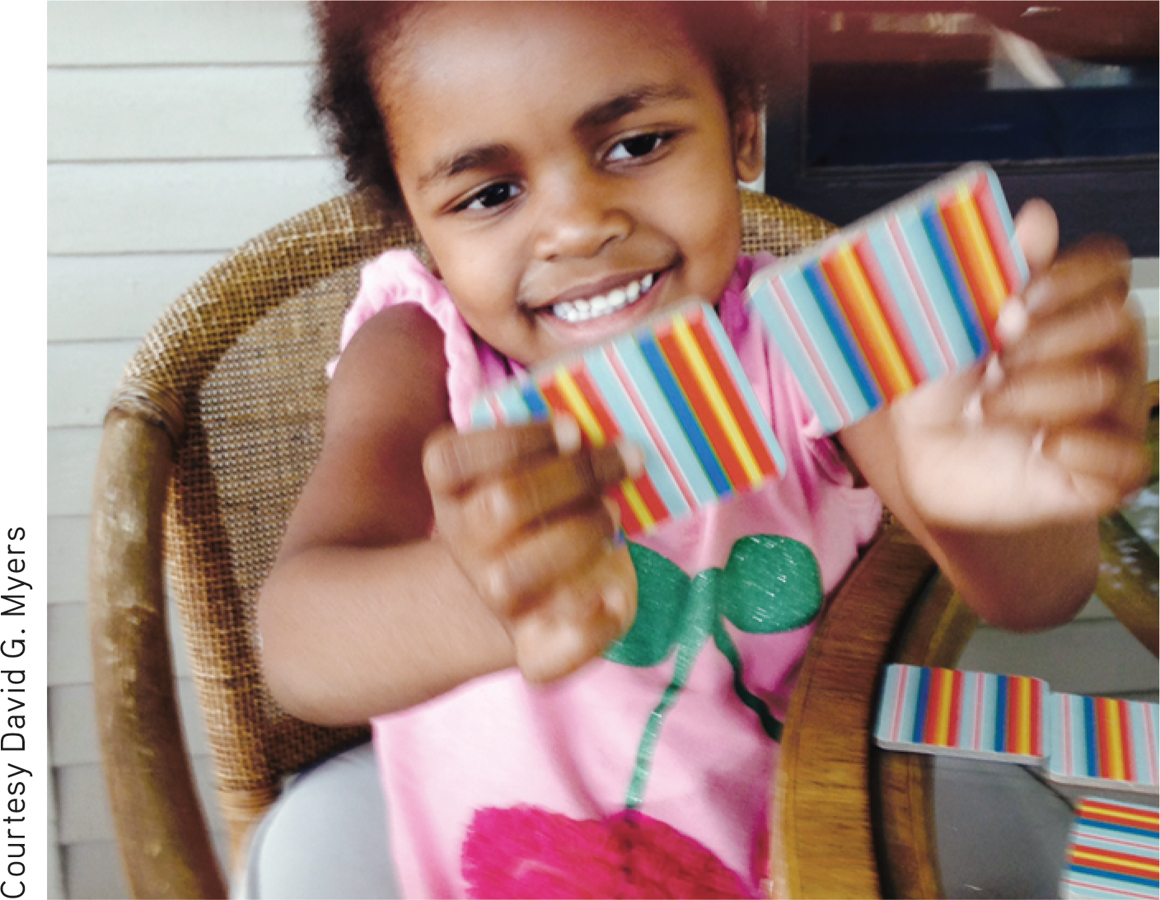
THEORY OF MIND When Little Red Riding Hood realized her “grandmother” was really a wolf, she swiftly revised her ideas about the creature’s intentions and raced away. Preschoolers, although still egocentric, develop this ability to infer others’ mental states when they begin forming a theory of mind (Premack & Woodruff, 1978).
Infants as young as 7 months show some knowledge of others’ beliefs (Kovács et al., 2010). With time, the ability to take another’s perspective develops. They come to understand what made a playmate angry, when a sibling will share, and what might make a parent buy a toy. And they begin to tease, empathize, and persuade.
Between about 3 and 4½, children worldwide come to realize that others may hold false beliefs (Callaghan et al., 2005; Rubio-Fernandez & Geurtz, 2013; Sabbagh et al., 2006). Jennifer Jenkins and Janet Astington (1996) showed Toronto children a Band-Aid box and asked them what was inside. Expecting Band-Aids, the children were surprised to discover that the box actually contained pencils. Asked what a child who had never seen the box would think was inside, 3-year-olds typically answered “pencils.” By age 4 to 5, the children’s theory of mind had leapt forward, and they anticipated their friends’ false belief that the box would hold Band-Aids.
In a follow-up experiment, children viewed a doll named Sally leaving her ball in a red cupboard (FIGURE 15.9). Another doll, Anne, then moved the ball to a blue cupboard. Researchers then posed a question: When Sally returns, where will she look for the ball? Children with autism spectrum disorder had difficulty understanding that Sally’s state of mind differed from their own—that Sally, not knowing the ball had been moved, would return to the red cupboard. They also have difficulty reflecting on their own mental states. They are, for example, less likely to use the personal pronouns I and me. Deaf children with hearing parents and minimal communication opportunities have had similar difficulty inferring others’ states of mind (Peterson & Siegal, 1999).
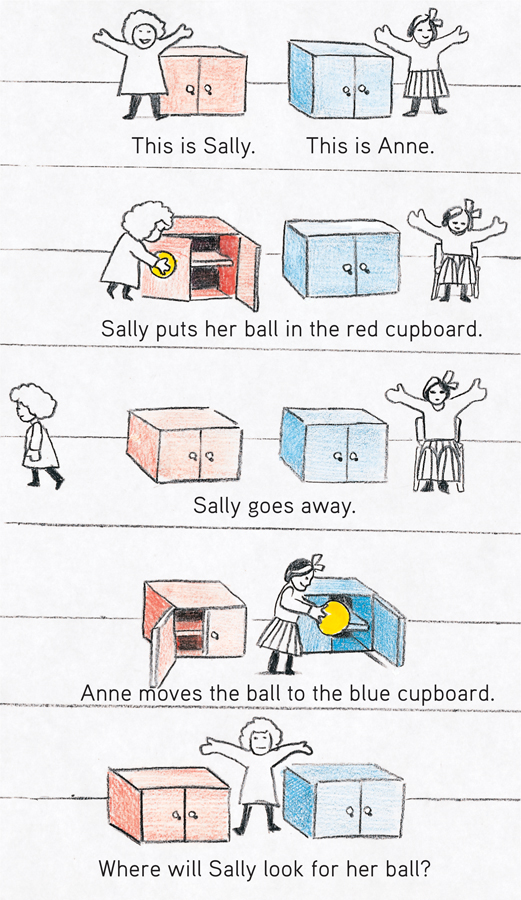
 Figure 15.9
Figure 15.9Testing children’s theory of mind This simple problem illustrates how researchers explore children’s presumptions about others’ mental states. (Inspired by Baron-Cohen et al., 1985.)
Concrete Operational StageBy about age 7, said Piaget, children enter the concrete operational stage. Given concrete (physical) materials, they begin to grasp conservation. Understanding that change in form does not mean change in quantity, they can mentally pour milk back and forth between glasses of different shapes. They also enjoy jokes that use this new understanding:
Mr. Jones went into a restaurant and ordered a whole pizza for his dinner. When the waiter asked if he wanted it cut into 6 or 8 pieces, Mr. Jones said, “Oh, you’d better make it 6, I could never eat 8 pieces!” (McGhee, 1976)
Piaget believed that during the concrete operational stage, children become able to comprehend mathematical transformations and conservation. When my [DM] daughter, Laura, was 6, I was astonished at her inability to reverse simple arithmetic. Asked, “What is 8 plus 4?” she required 5 seconds to compute “12,” and another 5 seconds to then compute 12 minus 4. By age 8, she could answer a reversed question instantly.
Formal Operational StageBy age 12, our reasoning expands from the purely concrete (involving actual experience) to encompass abstract thinking (involving imagined realities and symbols). As children approach adolescence, said Piaget, they can ponder hypothetical propositions and deduce consequences: If this, then that. Systematic reasoning, what Piaget called formal operational thinking, is now within their grasp.
Although full-blown logic and reasoning await adolescence, the rudiments of formal operational thinking begin earlier than Piaget realized. Consider this simple problem:
If John is in school, then Mary is in school. John is in school. What can you say about Mary?
Formal operational thinkers have no trouble answering correctly. But neither do most 7-year-olds (Suppes, 1982). TABLE 15.1 summarizes the four stages in Piaget’s theory.

 Table 15.1
Table 15.1Piaget’s Stages of Cognitive Development
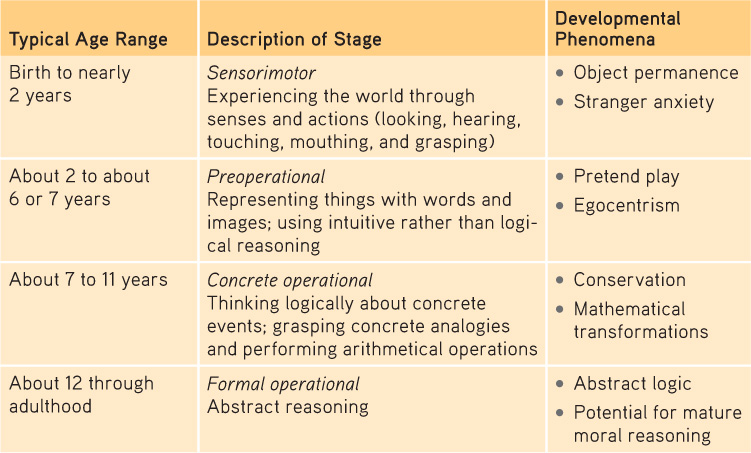
An Alternative Viewpoint: Lev Vygotsky and the Social Child
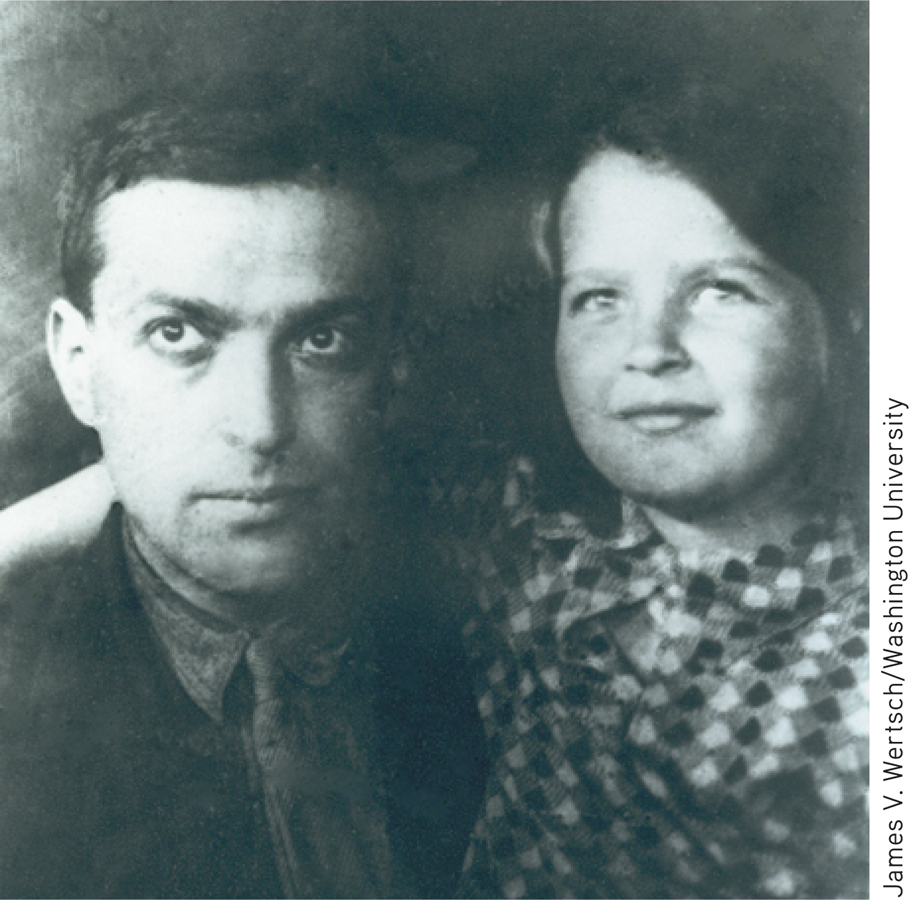
As Piaget was forming his theory of cognitive development, Russian psychologist Lev Vygotsky was also studying how children think and learn. He noted that by age 7, they increasingly think in words and use words to solve problems. They do this, he said, by internalizing their culture’s language and relying on inner speech (Fernyhough, 2008). Parents who say “No, no!” when pulling a child’s hand away from a cake are giving the child a self-control tool. When the child later needs to resist temptation, he may likewise say “No, no!” Second graders who muttered to themselves while doing math problems grasped third-grade math better the following year (Berk, 1994). Whether out loud or inaudibly, talking to themselves helps children control their behavior and emotions and master new skills.
Where Piaget emphasized how the child’s mind grows through interaction with the physical environment, Vygotsky emphasized how the child’s mind grows through interaction with the social environment. If Piaget’s child was a young scientist, Vygotsky’s was a young apprentice. By mentoring children and giving them new words, parents and others provide a temporary scaffold from which children can step to higher levels of thinking (Renninger & Granott, 2005). Language, an important ingredient of social mentoring, provides the building blocks for thinking, noted Vygotsky (who was born the same year as Piaget, but died prematurely of tuberculosis).
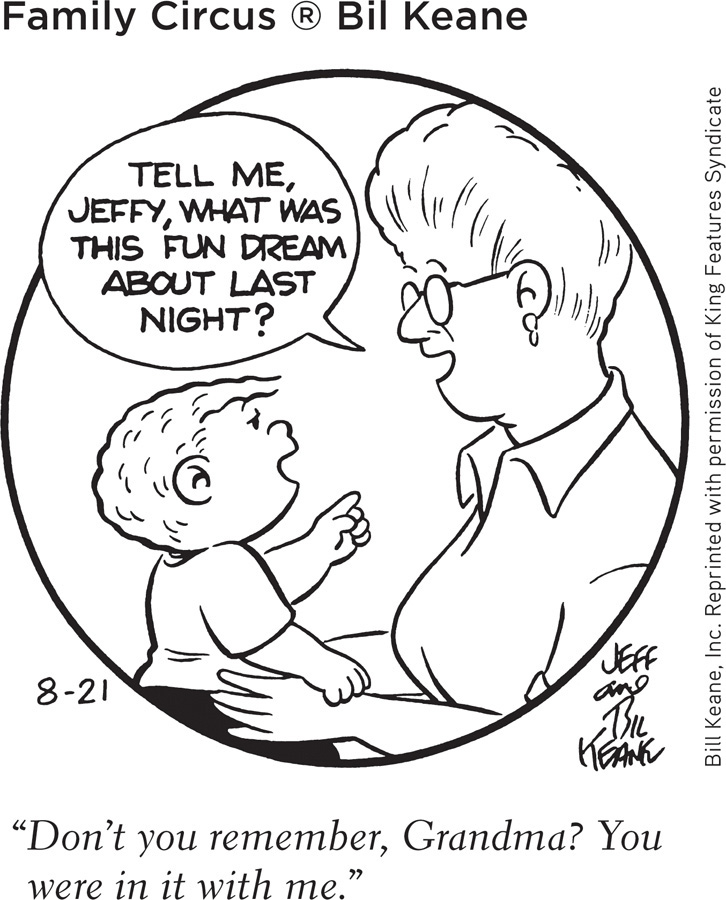
RETRIEVAL PRACTICE
- Object permanence, pretend play, conservation, and abstract logic are developmental milestones for which of Piaget’s stages, respectively?
Object permanence for the sensorimotor stage, pretend play for the preoperational stage, conservation for the concrete operational stage, and abstract logic for the formal operational stage.
- Match the correct cognitive developmental stage (a-d) to each developmental phenomenon (1–6).
- Sensorimotor
- Preoperational
- Concrete operational
- Formal operational
- Thinking about abstract concepts, such as “freedom.”
- Enjoying imaginary play (such as dress-up).
- Understanding that physical properties stay the same even when objects change form.
- Having the ability to reverse math operations.
- Understanding that something is not gone for good when it disappears from sight, as when Mom “disappears” behind the shower curtain.
- Having difficulty taking another’s point of view (as when blocking someone’s view of the TV).
1. d, 2. b, 3. c, 4. c, 5. a, 6. b
Reflecting on Piaget’s Theory
“Assessing the impact of Piaget on developmental psychology is like assessing the impact of Shakespeare on English literature.”
Developmental psychologist Harry Beilin (1992)
What remains of Piaget’s ideas about the child’s mind? Plenty—enough to merit his being singled out by Time magazine as one of the twentieth century’s 20 most influential scientists and thinkers, and to his being rated in a survey of British psychologists as the last century’s greatest psychologist (Psychologist, 2003). Piaget identified significant cognitive milestones and stimulated worldwide interest in how the mind develops. His emphasis was less on the ages at which children typically reach specific milestones than on their sequence. Studies around the globe, from aboriginal Australia to Algeria to North America, have confirmed that human cognition unfolds basically in the sequence Piaget described (Lourenco & Machado, 1996; Segall et al., 1990).
However, today’s researchers see development as more continuous than did Piaget. By detecting the beginnings of each type of thinking at earlier ages, they have revealed conceptual abilities Piaget missed. Moreover, they see formal logic as a smaller part of cognition than he did. Piaget would not be surprised that today, as part of our own cognitive development, we are adapting his ideas to accommodate new findings.
“Childhood has its own way of seeing, thinking, and feeling, and there is nothing more foolish than the attempt to put ours in its place.”
Philosopher Jean-Jacques Rousseau, 1798
Implications for Parents and TeachersFuture parents and teachers remember: Young children are incapable of adult logic. Preschoolers who block one’s view of the TV simply have not learned to take another’s viewpoint. What seems simple and obvious to us—getting off a teeter-totter will cause a friend on the other end to crash—may be incomprehensible to a 3-year-old. Also remember that children are not passive receptacles waiting to be filled with knowledge. Better to build on what they already know, engaging them in concrete demonstrations and stimulating them to think for themselves. And, finally, accept children’s cognitive immaturity as adaptive. It is nature’s strategy for keeping children close to protective adults and providing time for learning and socialization (Bjorklund & Green, 1992).
 For a 7-minute synopsis of Piaget’s concepts, see LaunchPad’s Video: Cognitive Development.
For a 7-minute synopsis of Piaget’s concepts, see LaunchPad’s Video: Cognitive Development.
Autism Spectrum Disorder
15-3 What is autism spectrum disorder?
Diagnoses of autism spectrum disorder (ASD), a disorder marked by social deficiencies and repetitive behaviors, have been increasing. Once believed to affect 1 in 2500 children (and referred to simply as autism), ASD now gets diagnosed in 1 in 68 American children at age 8. But the reported rates vary by place, with New Jersey having four times the reported prevalence of Alabama, while Britain’s children have a 1 in 100 rate, and South Korea’s 1 in 38 (CDC, 2014; Kim et al., 2011; NAS, 2011). The increase in ASD diagnoses has been offset by a decrease in the number of children with a “cognitive disability” or “learning disability,” which suggests a relabeling of children’s disorders (Gernsbacher et al., 2005; Grinker, 2007; Shattuck, 2006). A massive $6.7 billion National Children’s Study now under way has enrolled some 100,000 pregnant women to follow their babies until they turn 21—partly in hopes of explaining the rising rates of ASD, as well as premature births, childhood obesity, and asthma (Belluck, 2010; Murphy, 2008).
The underlying source of ASD’s symptoms seems to be poor communication among brain regions that normally work together to let us take another’s viewpoint. From age 2 months on, as other children spend more and more time looking into others’ eyes, those who later develop ASD do so less and less (Jones & Klin, 2013). People with ASD are said to have an impaired theory of mind (Rajendran & Mitchell, 2007; Senju et al., 2009). Mind reading that most of us find intuitive (Is that face conveying a smirk or a sneer?) is difficult for those with ASD. They have difficulty inferring and remembering others’ thoughts and feelings, learning that twinkling eyes mean happiness or mischief, and appreciating that playmates and parents might view things differently (Boucher et al., 2012; Frith & Frith, 2001). Partly for such reasons, a national survey of parents and school staff reported that 46 percent of adolescents with ASD had suffered the taunts and torments of bullying—four times the 11 percent rate for other children (Sterzing et al., 2012). In hopes of a cure, desperate parents have sometimes subjected children to dubious therapies (Shute, 2010).

ASD has differing levels of severity. Some (those diagnosed with what used to be called Asperger syndrome) generally function at a high level. They have normal intelligence, often accompanied by exceptional skill or talent in a specific area, but deficient social and communication skills and a tendency to become distracted by irrelevant stimuli (Remington et al., 2009).
Biological factors, including genetic influences and abnormal brain development, contribute to ASD (State & Šestan, 2012). Studies suggest that the prenatal environment matters, especially when altered by maternal infection and inflammation, psychiatric drug use, or stress hormones (NIH, 2013; Wang, 2014). Childhood MMR vaccinations do not (Demicheli et al., 2012; DeStefano et al., 2013). Based on a fraudulent 1998 study—“the most damaging medical hoax of the last 100 years” (Flaherty, 2011)—some parents were misled into thinking that the childhood MMR vaccine increased risk of ASD. The unfortunate result was a drop in vaccination rates and an increase in cases of measles and mumps. Some unvaccinated children suffered long-term harm or even death.
ASD afflicts about four boys for every girl. Children for whom amniotic fluid analyses indicated high prenatal testosterone develop more masculine and ASD-related traits (Auyeung et al., 2009). Psychologist Simon Baron-Cohen (2008, 2009) argues that ASD represents an “extreme male brain.” Girls are naturally predisposed to be “empathizers,” he contends. They tend to be better at reading facial expressions and gestures, though less so if given testosterone (van Honk et al., 2011). And, although the sexes overlap, he believes boys are more often “systemizers”—better at understanding things according to rules or laws, as in mathematical and mechanical systems.
If two tech-minded systemizers mate, then does that increase both the rate of this type of cognitive talent—and also ASD—among their offspring? Indeed, Baron-Cohen (2012) reports, ASD rates are higher not only among elite math students, but also among the children and grandchildren of engineers and MIT graduates. Eindhoven—the engineering and computing hub city of the Netherlands—has triple the rate of schoolchildren with ASD as that in other Dutch cities (Roelfsema et al., 2012).

Twin and sibling studies verify biology’s influence. If one identical twin is diagnosed with ASD, the chances are 50 to 70 percent that the co-twin will be as well (Lichtenstein et al., 2010; Sebat et al., 2007). A younger sibling of a child with ASD also is at a heightened risk (Sutcliffe, 2008). No one “autism gene” accounts for the disorder. Rather, many genes—with more than 200 identified so far—appear to contribute (Heil & Schaaf, 2013). Random genetic mutations in sperm-producing cells may also play a role. As men age, these mutations become more frequent, which may help explain why an over-40 man has a much higher risk of fathering a child with ASD than does a man under 30 (Reichenberg et al., 2007).

Researchers are also sleuthing ASD’s telltale signs in the brain’s structure. Several studies have revealed “underconnectivity”—fewer than normal fiber tracts connecting the front of the brain to the back (Ecker et al., 2012; Just et al., 2012; Wolff et al., 2012). With underconnectivity, there is less of the whole-brain synchrony that, for example, integrates visual and emotional information.
Biology’s role in ASD also appears in the brain’s functioning. People without ASD often yawn after seeing others yawn. And as they view and imitate another’s smiling or frowning, they feel something of what the other is feeling. Not so among those with ASD, who are less imitative and show much less activity in brain areas involved in mirroring others’ actions (Dapretto et al., 2006; Perra et al., 2008; Senju et al., 2007). When people with ASD watch another person’s hand movements, for example, their brain displays less than normal mirroring activity (Oberman & Ramachandran, 2007; Théoret et al., 2005). Scientists are exploring and debating this idea that the brains of people with ASD have “broken mirrors” (Gallese et al., 2011). And they are exploring whether treatment with oxytocin, the hormone that promotes social bonding, might improve social behavior in those with ASD (Gordon et al., 2013; Lange & McDougle, 2013).
Seeking to “systemize empathy,” Baron-Cohen and his Cambridge University colleagues (2007; Golan et al., 2010) collaborated with Britain’s National Autistic Society and a film production company. Knowing that television shows with vehicles have been popular among kids with ASD, they created animations with toy vehicle characters in a pretend boy’s bedroom, grafting emotion-conveying faces onto toy trams, trains, and tractors (FIGURE 15.10). After the boy leaves for school, the characters come to life and have experiences that lead them to display various emotions (see www.thetransporters.com). The children were surprisingly able to generalize what they had learned to a new, real context. By the intervention’s end, their previously deficient ability to recognize emotions on real faces now equaled that of children without ASD.
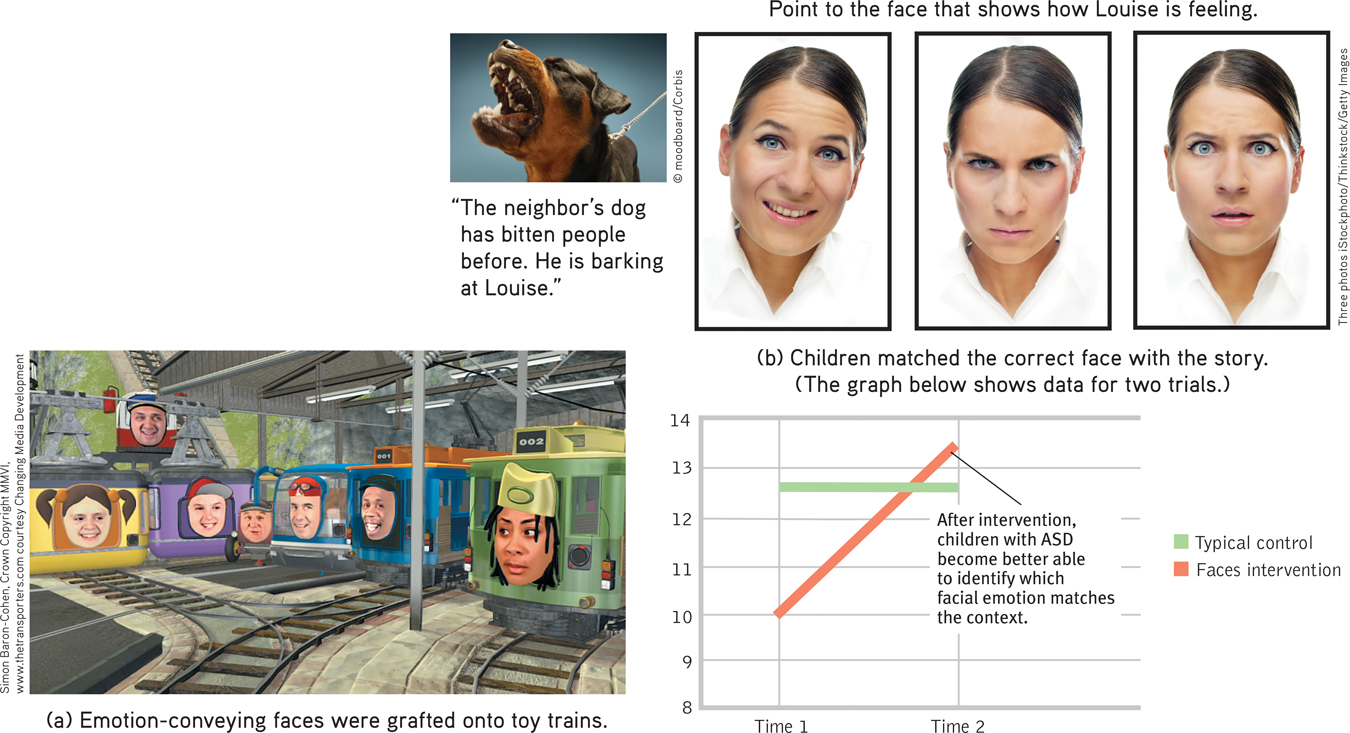
 Figure 15.10
Figure 15.10Transported into a world of emotion (a) A research team at Cambridge University’s Autism Research Centre introduced children with ASD to emotions experienced and displayed by toy vehicles. (b) After four weeks of viewing animations, the children displayed a markedly increased ability to recognize emotions not only in the toy faces but also in humans.
RETRIEVAL PRACTICE
- What does theory of mind have to do with autism spectrum disorder?
Theory of mind focuses on our ability to understand our own and others’ mental states. Those with autism spectrum disorder struggle with this ability.